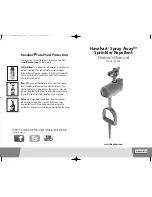
A word about TDS and PPM…
From Wikipedia, the free encyclopedia
“A
TDS Meter
indicates the Total Dissolved Solids (TDS) of a solution, i.e. the
concentration of dissolved solids in it. Since dissolved ionized solids such as
salts and minerals increase the conductivity of a solution, a TDS meter
measures the conductivity of the solution and estimates the TDS from that.
A TDS meter typically displays the TDS in parts per million (ppm). For exam-
ple, a TDS reading of 1 ppm would indicate there is 1 milligram of dis-
solved solids in each kilogram of water.” TDS is a measure of total dis-
solved solids and
NOT dissolved contaminants
. A higher TDS can simply be
high calcium or mineral content. As Propur™ filters are made from miner-
als, TDS may be higher after the water has been treated. This does not
mean the filter isn’t working, it means the TDS meter is picking up the min-
erals that are naturally released by the filter. A PPM meter is the same as a
TDS meter, it is simply measures dissolved solids in water. A TDS meter is not
generally recognized in the industry as a proper means of testing water for
contaminants. They were created years ago by the manufacturers of re-
verse osmosis systems as a means of demonstrating the effectiveness of
RO which removes most if not all minerals.
The ProOne
®
G2.0 filter is available in 4 sizes to fit all Propur
TM
systems
and most other brands of gravity systems. Choose the most ad-
vanced gravity water filter – choose the ProOne G2.0
®
by Propur
TM
.
4






























